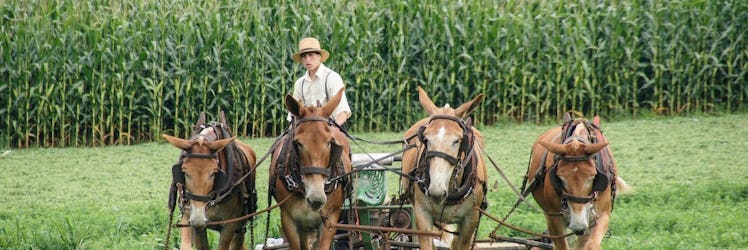How The Amish Raise Kids That Ask To Do Chores
Where "screen time" involves building things with screens.

When you think of Amish, you probably think of horse-drawn carriages, barn-raisings, and Kingpin. Yes, the Amish do, in fact, use horse-drawn carriages (and are apparently kind of shitty drivers), and yes they also live completely off the grid in very rural places. And, yes, they’re all excellent bowlers. But the Amish also raise well-behaved children who really contribute to the household. Gideon Stoll is an Amish father of 7 (3 sons and 4 daughters) in Maine, who says that the old traditions and sense of personal responsibility have benefited his kids more than your English ways of life — what with your waffle irons, Chevrolets, and non-child-powered washing machines.
READ MORE: The Fatherly Guide to Chores
The Family That Farms Together Stays Together
“Traditionally, as Amish, we farm, because farming takes a whole family,” says Stoll. He admits there isn’t a lot of money in it, but there is a lot of family time. The children are expected to be responsible from as early as 5, where a first chore might be something like loading the wood box every night (that would be the place you keep your wood). At 10 you might be expected to collect and wash the eggs. And at 16, you’re the teenager who grumbles about feeding the horses.
No Culture Is Immune From Teen Angst
Getting pissed isn’t really the Amish way, but as Stoll remembers, one Christmas he and his son Jason were doing chores (unlike most kids that morning who were complaining they got the wrong WWE game). Jason wanted to go build an ice house for this world renowned chef instead of taking care of the horses. His dad said that his teenage son never listens. There was some angry chore-doing that day. But Stoll recognized he was being overbearing and apologized to his son. “I was disrespectful to his feelings,” he says. “If I would have been patient, he would have done his chores anyhow, and I wouldn’t have gotten upset.”
Train Your Kids Well
“We aim to have happy children, and a toddler can be taught that no means no,” says Stoll. A big emphasis is put on manners and a consistent practice of those manners. So when he sees a kid throwing a tantrum in the middle of Wal-Mart, “that’s child abuse. If he was trained properly, he would not act like that.” What kind of training? The next time your 5-year-old forgets to empty that wood box at night, make them do it in their PJs. Don’t own a wood box? Taking out the recycling is the suburban equivalent.
Don’t Be Afraid To Put Them To Work
When Stoll’s son Caleb was 11 he started milking 25 cows every evening at a neighboring farm. He rode his bike 2 and a half miles away, in the cold, snow, and dark. Every damn day. But for his hard work, Caleb did earn a gallon of milk, and plenty of cheese and butter. “My family can drink a lot of milk,” says Stoll. Hmm, so milk was a good choice.
How The Amish Have Fun
So you thought that Amish life was all barn-raising and beard-stroking. Well, on Thursdays all the men in the community get together and help on a little community project. It’s your typical get-together: Building an ice house or roofing your community store. And while nobody is taking their lunch break to hit up their CrossFit box, they do go on over and play bombardment with the kids (which is like Amish CrossFit). “You gotta have some fun once in awhile,” says Stoll.
Get Back On That Horse
Sometimes you need to tell your child they need to literally get back up on that horse. One day a few kids went to go ride horses, but they went too far and some of them got hurt. Instead of yelling at the kids, they were told, “You need to get back on the horse so the horse doesn’t win — otherwise you’ll be scared for the rest of your life.” Or at least the horse’s life.
Keep The Community Local
It’s not that the Amish don’t accept motorized transport, it’s that the easier it is to get around, the easier it is for their community to spread out. Stoll pointed out that when Henry Ford invented the car he said it would bring everyone together. “It did the opposite,” he says. The Amish have solved the problem of keeping their people close by buying farms within easy cycling/clopping distance from each other.
This article was originally published on